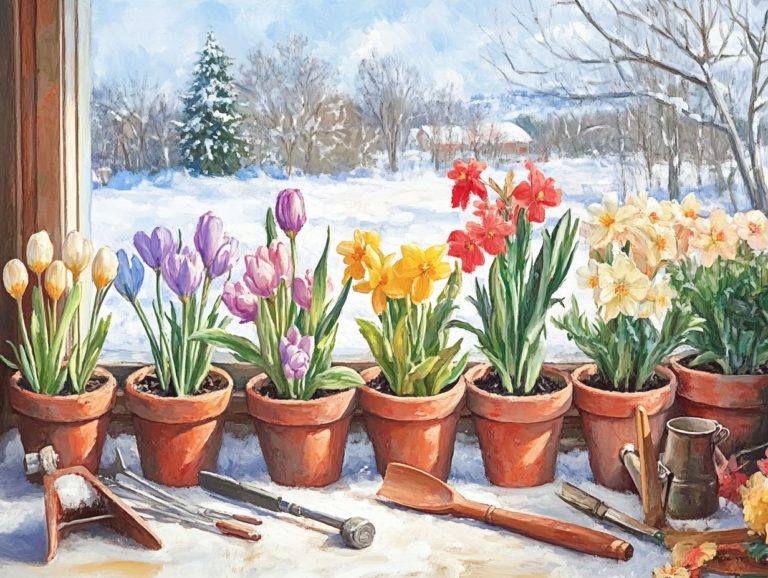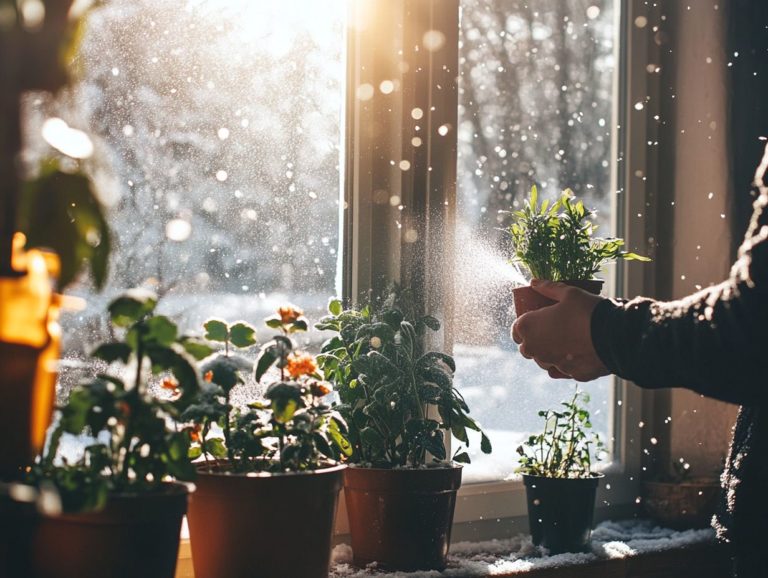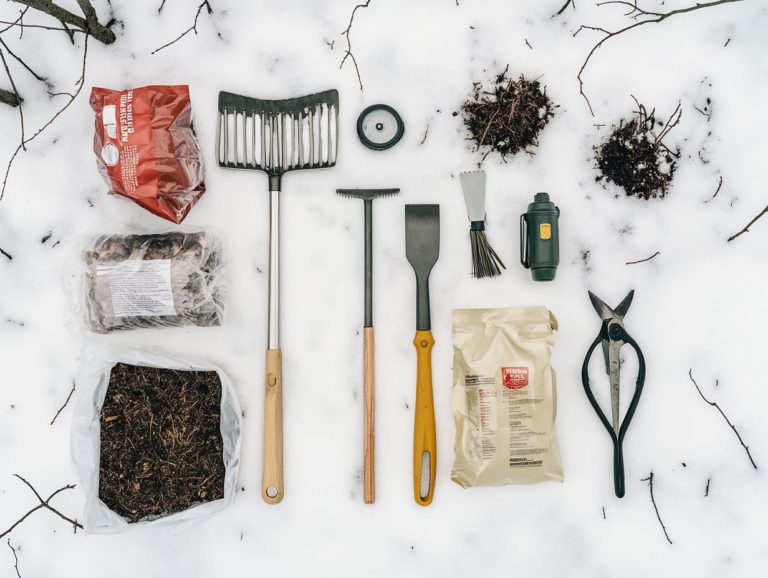How to Store Garden Tools for Winter
As winter approaches, it’s essential to consider how to care for your garden tools, ensuring they remain in prime condition for the next planting season. With the right cleaning, maintenance, and storage techniques, you can safeguard your investment and prolong the lifespan of your gardening equipment. This guide will provide you with everything you need to know, from selecting the ideal storage location to organizing your tools efficiently. It also provides tips for winterizing specific tools, helping you maintain their excellent condition throughout the colder months. Now, let’s dive in your garden tools will love this care!
Contents
- Key Takeaways:
- Preparing Garden Tools for Winter Storage
- Choosing the Right Storage Location
- Organizing and Storing Garden Tools
- Preparing for Winter
- Tips for Maintaining Tools During Winter
- Frequently Asked Questions
- What are the necessary steps to properly store garden tools for winter?
- What is the benefit of cleaning and sharpening garden tools before storing them for winter?
- Can I store garden tools in a shed or garage during the winter?
- Should I apply oil to all metal parts of my garden tools before storing them?
- Is it necessary to label garden tools before storing them for winter?
- What should I do if I notice any damage to my garden tools before storing them for winter?
Key Takeaways:
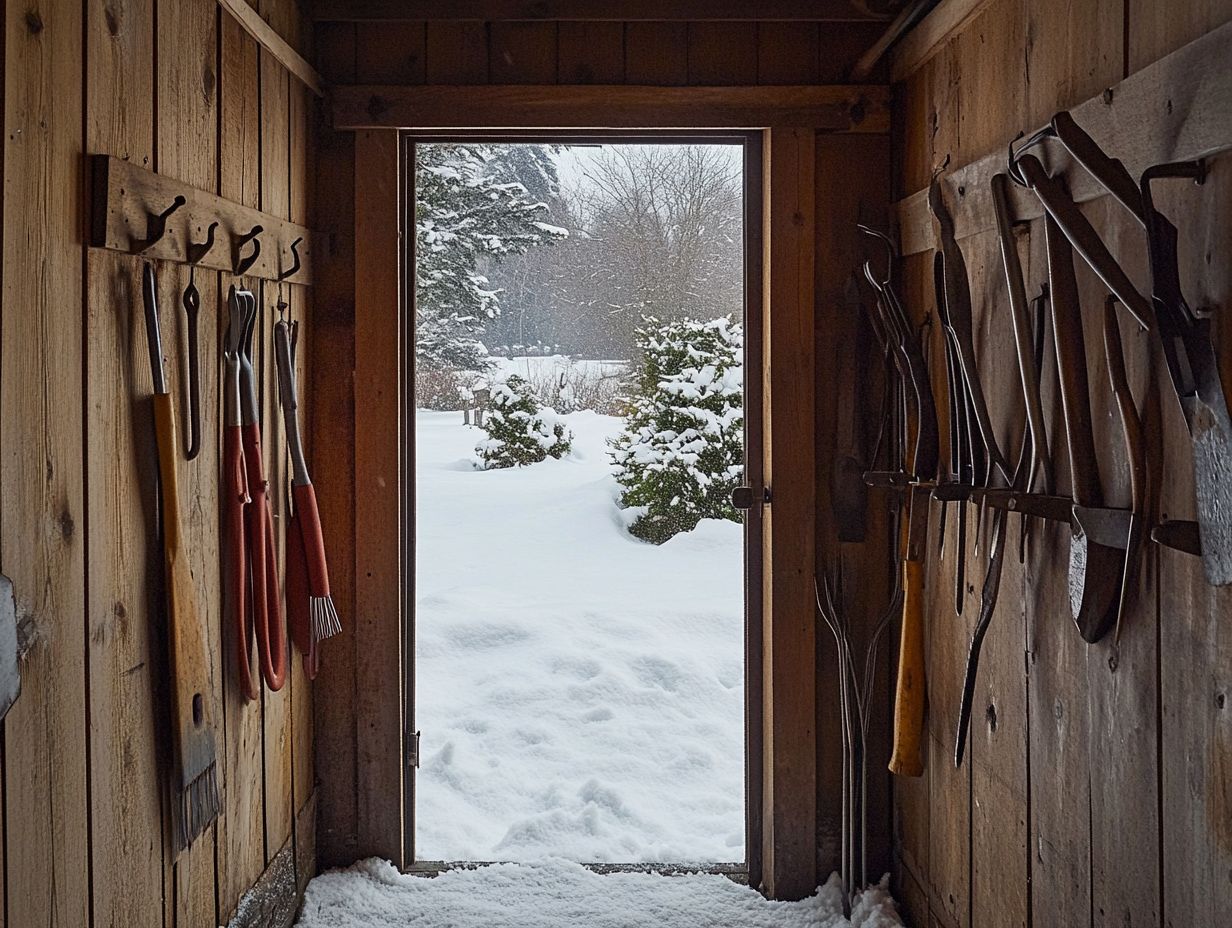
- Clean and maintain garden tools before storing them for the winter to prevent rust and damage.
- Choose a suitable storage location based on the type of tools and climate, such as indoor storage for delicate tools and outdoor storage for larger ones.
- Properly organize and store garden tools by placing them in a protected and easily accessible area to prolong their lifespan and prevent accidents.
Preparing Garden Tools for Winter Storage
As winter draws near, preparing your garden tools for storage is essential for ensuring their longevity and effectiveness. This process involves cleaning, maintaining, and organizing your tools to shield them from rust and damage, which is vital for successful gardening in the upcoming season.
Whether your tools are made of metal or feature wooden handles, giving them proper care will prevent deterioration and ensure you re ready for those spring gardening tasks. Overlooking this crucial step could result in performance issues and costly repairs when you need your tools the most.
Cleaning and Maintenance
Cleaning and maintaining your garden tools is crucial for extending their lifespan and ensuring they perform at their best during your gardening tasks. Regular upkeep helps prevent rust and deterioration, making sure your pruners, shovels, and hoes are always ready to meet your gardening needs.
To achieve this, you ll want to employ various cleaning techniques tailored to each tool. For example, applying a bit of vegetable oil on metal parts can create a protective barrier against moisture, while specialized metal cleaners will work wonders in eliminating any existing rust. Don t forget to disinfect your tools after each use, especially those involved in pruning or repairs, to prevent the spread of plant diseases.
By keeping your tools clean and properly maintained, you can significantly enhance their durability and performance, ultimately creating a healthier environment for your garden to thrive.
Choosing the Right Storage Location
Selecting the ideal storage location for your garden tools is vital in safeguarding them against harsh winter weather, which can cause rust and damage if not addressed. Whether you decide on an indoor space, such as a garage or shed, or an outdoor area, it’s important to factor in elements like humidity, temperature, and accessibility when preparing your tools for the colder months.
Indoor vs. Outdoor Storage
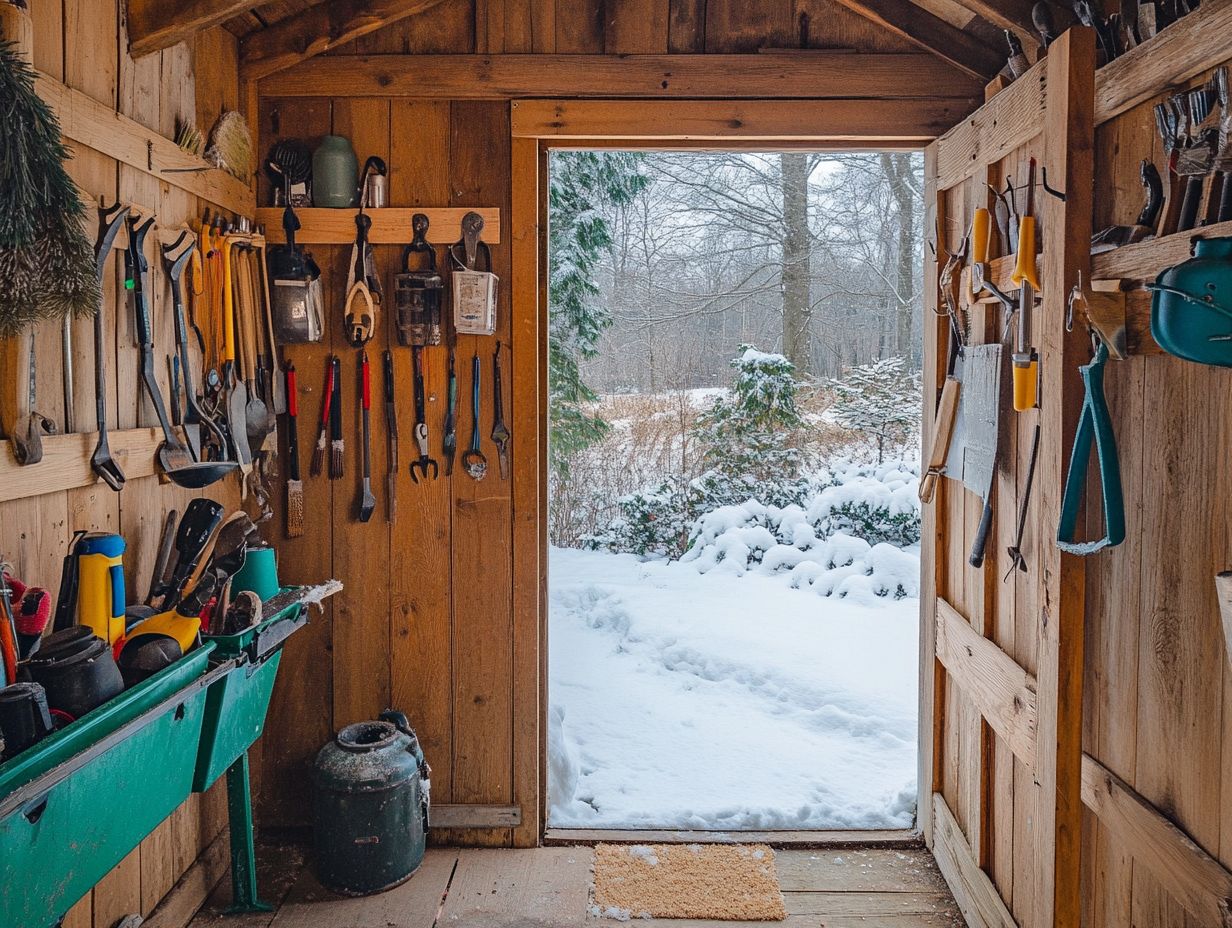
When storing your garden tools for winter, the choice between indoor and outdoor storage is crucial, as each option has distinct advantages and challenges that can impact the lifespan of your equipment. Indoor storage effectively shields your tools from harsh winter elements, while outdoor storage requires more protective measures to prevent rust and damage.
For example, a climate-controlled indoor space creates a stable environment that minimizes moisture and temperature fluctuations, significantly reducing the risk of corrosion. However, this option may require more effort regarding organization and space management.
Conversely, outdoor sheds offer unmatched convenience, allowing you easy access straight from your garden. Yet, they require regular upkeep, such as ensuring waterproofing and proper ventilation to maintain your tools in top-notch condition.
Ultimately, choosing the right storage solution is a balancing act between ease of access and environmental protection, significantly influencing the maintenance needed for your essential gardening gear.
Organizing and Storing Garden Tools
Organizing and storing your garden tools effectively is essential for preserving their quality and ensuring effortless access when spring blooms. By adopting an organized method to tool placement and employing protective measures, you can extend the lifespan of your tools and enhance the efficiency of your gardening endeavors.
Proper Tool Placement and Protection
Proper tool placement and protection are essential for preserving your garden tools throughout the winter months, ensuring they re ready for action when spring arrives. Arranging your tools to minimize contact and prevent damage, along with protective storage methods, can significantly extend their lifespan.
One effective strategy is to incorporate racks or pegboards into your storage system. This allows for easy access while keeping your tools visible and organized. Using cloth wraps or fitted covers shields them from dust, moisture, and potential rust buildup. Make it a habit to clean your tools after every use; removing dirt or debris is crucial to prevent corrosion.
By implementing these best practices, you ensure that your garden tools are not only well-maintained but also easily accessible and ready for immediate use when the gardening season rolls around again.
Preparing for Winter
Preparing your garden tools for winter is essential for ensuring they stay functional and effective when it’s time to dive back into gardening. Each tool requires its own unique care routine to prevent rust, maintain sharpness, and guarantee they re primed for action when the gardening season begins anew.
Special Considerations for Different Tools
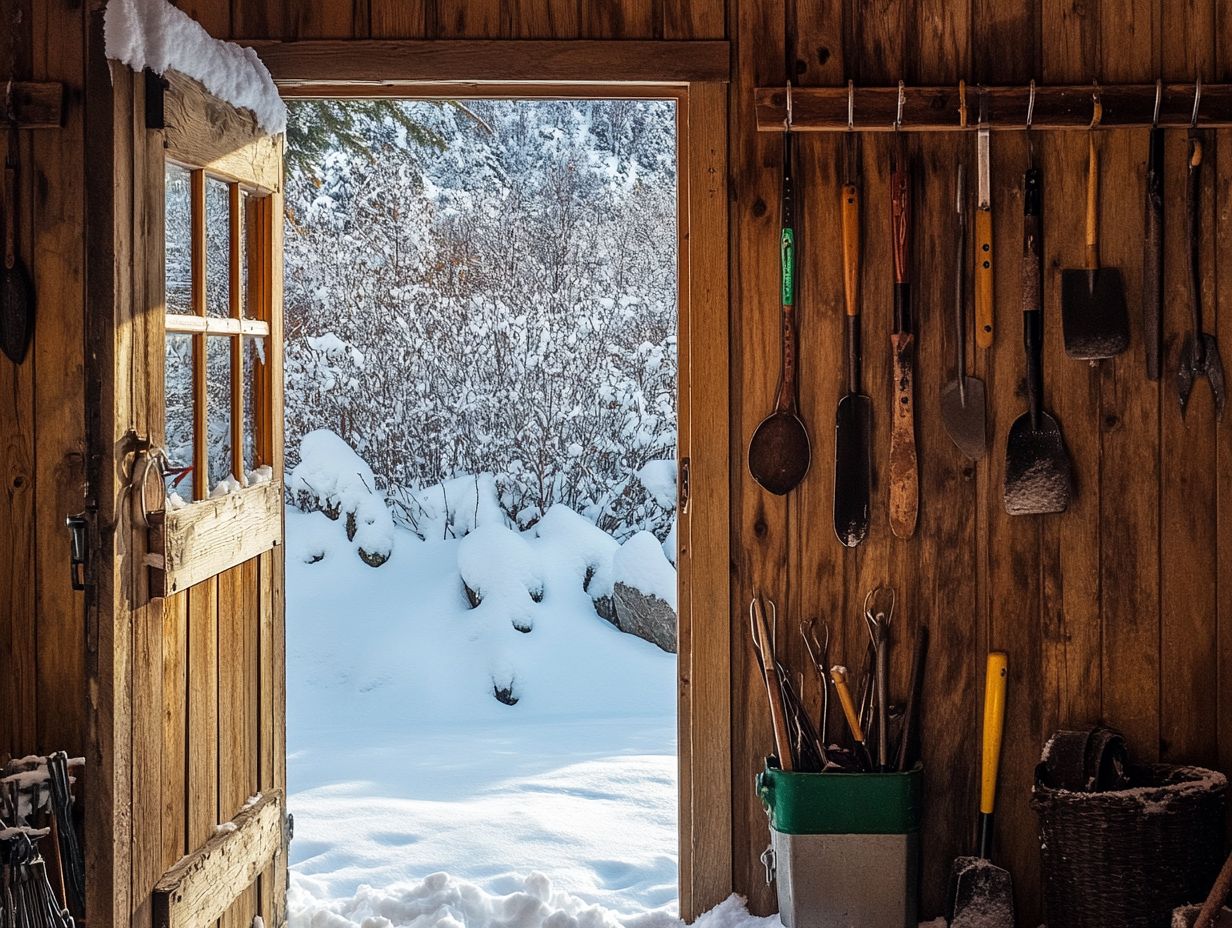
Each type of garden tool comes with its own winterizing considerations, as the materials and functions dictate how you should care for them to prevent damage and ensure longevity. For instance, metal tools often benefit from an oil treatment to ward off rust. Tools with wooden handles may need some conditioning to keep their integrity intact.
For plastic tools, storing them in a cool, dry place is essential to avoid cracking or warping from extreme temperatures. Make it a habit to clean all your tools thoroughly after each use, ensuring that soil and debris are completely removed.
For tools with intricate parts, like pruners or shears, taking the time to disassemble them for a detailed cleaning can significantly prolong their lifespan. Regularly inspecting your tools for signs of wear and addressing these issues promptly can save you considerable costs in the long run.
By implementing these practices, you create a reliable system for maintaining a well-functioning set of garden tools that will serve you well season after season.
Tips for Maintaining Tools During Winter
Maintaining your garden tools during the winter months requires a thoughtful approach to ensure they remain in peak condition. Understanding the importance of quality garden tools in winter is essential for the upcoming gardening season.
Implement straightforward strategies such as routinely inspecting for rust, reapplying oil, and keeping your tools clean. Doing so can greatly extend their lifespan and enhance their functionality.
Investing this time now will pay off when it comes time to dig into your garden. Get started on organizing your tools today, and be ready to dig in when spring arrives!
Preventative Measures and Maintenance Techniques
Applying preventative measures and maintenance techniques during the winter months is vital for preserving the integrity of your garden tools. Simple steps like cleaning and oiling can combat rust and prepare your tools for the next gardening season.
Begin by thoroughly washing your tools with soapy water to eliminate dirt and debris. Then, dry them completely to prevent moisture. Experts recommend using mineral oil on metal components, as it creates a protective barrier against the elements. For wooden handles, a light coat of linseed oil nourishes and fortifies the wood.
For optimal storage, keep your tools in a cool, dry area, and consider hanging them to avoid unnecessary contact with damp surfaces. By following these maintenance practices, you will significantly enhance the longevity and performance of your tools, ensuring they are ready for action when spring arrives.
Frequently Asked Questions
What are the necessary steps to properly store garden tools for winter?
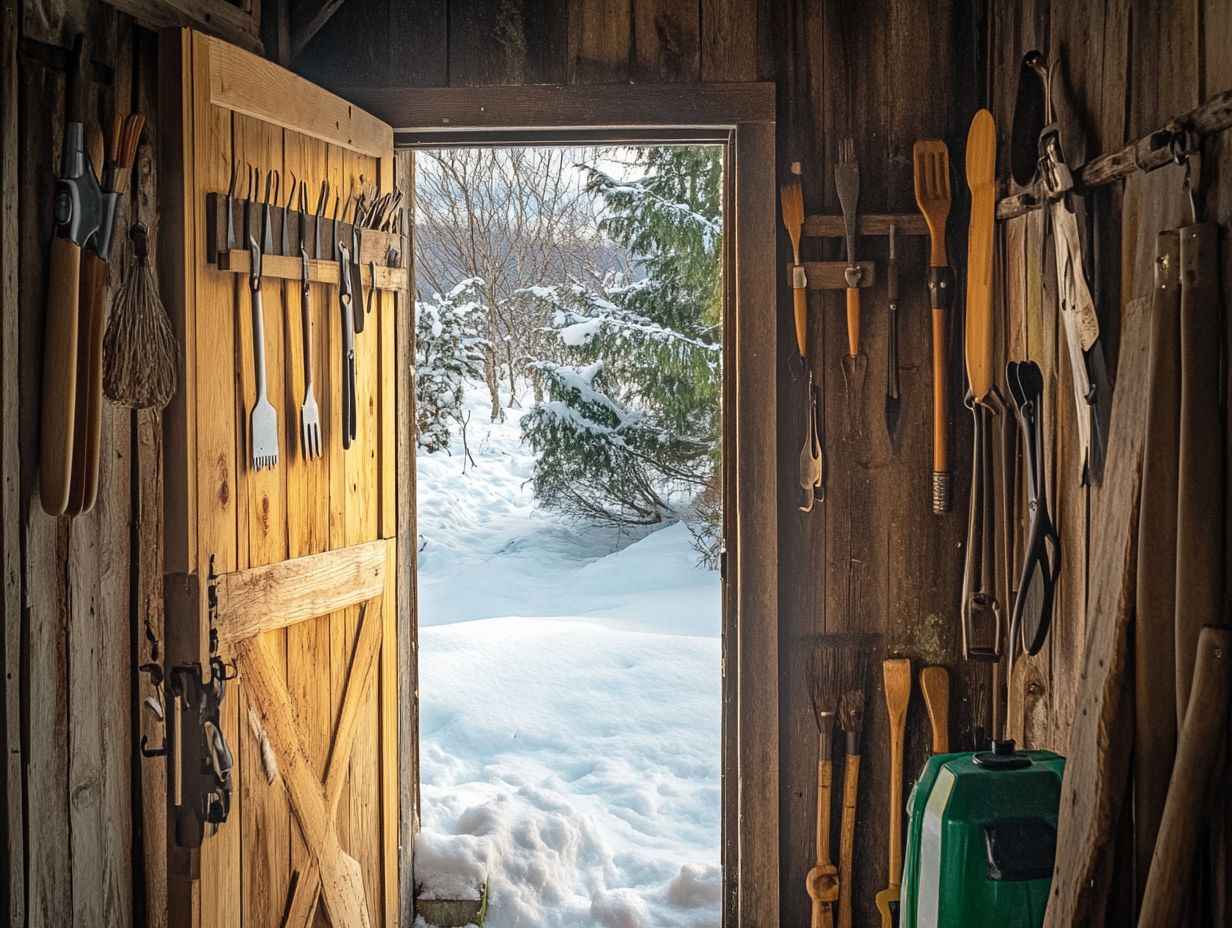
To properly store garden tools for winter, follow these steps:
- Clean tools thoroughly – remove any dirt or debris.
- Sharpen blades – use a sharpening stone or file for cutting tools.
- Oil metal parts – put a small amount of oil on metal parts to prevent rust.
- Check for damage – inspect tools for any signs of damage.
- Store in a dry place – ensure tools are kept dry to prevent rust.
- Organize and label – organize tools for easy identification in spring.
What is the benefit of cleaning and sharpening garden tools before storing them for winter?
Cleaning and sharpening garden tools before storage prolongs their lifespan and keeps them in good condition for spring. Removing dirt and debris prevents rust and corrosion, while sharpening blades allows for more efficient use next gardening season.
Can I store garden tools in a shed or garage during the winter?
Yes, you can store garden tools in a shed or garage during the winter, as long as the space is dry and well-ventilated. Keep your tools off the ground to protect them and make access easier for spring!
Should I apply oil to all metal parts of my garden tools before storing them?
Yes, it’s a good idea to put a small amount of oil on all metal parts before storing them for winter. This helps prevent rust and corrosion, especially if the tools will be kept in a damp location.
Is it necessary to label garden tools before storing them for winter?
Labeling garden tools before storage isn t strictly necessary but can be helpful in spring when gardening resumes. This way, you can easily identify which tools are where.
What should I do if I notice any damage to my garden tools before storing them for winter?
If you see damage to your tools, fix it right away to ensure they re ready for spring. This may include replacing broken handles or sharpening dull blades.




